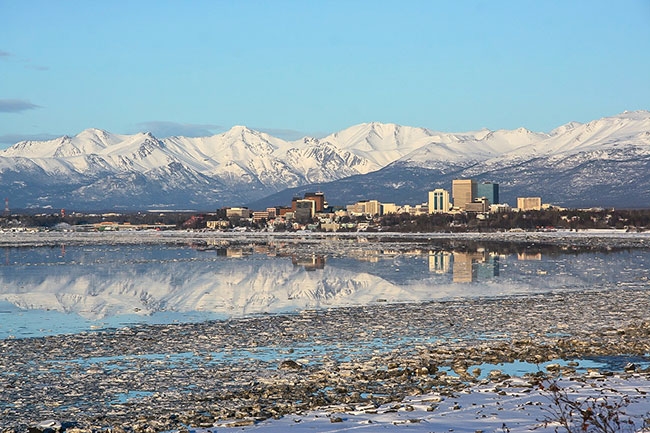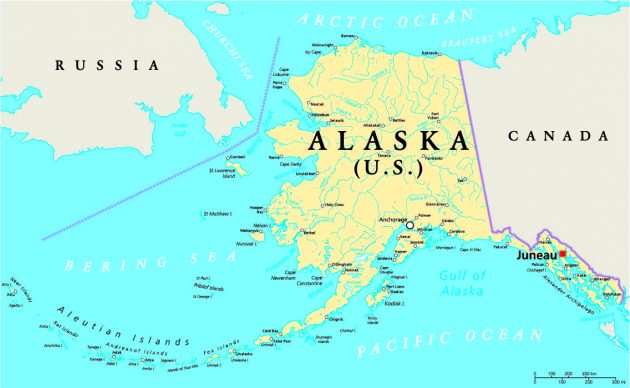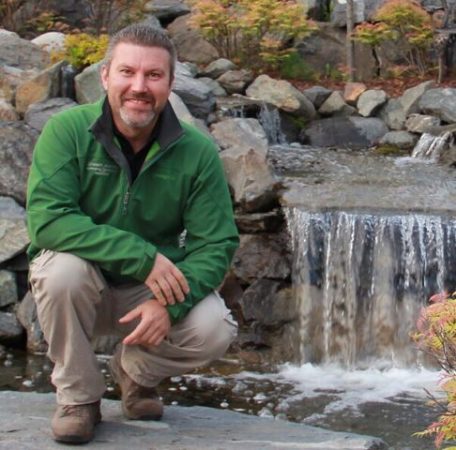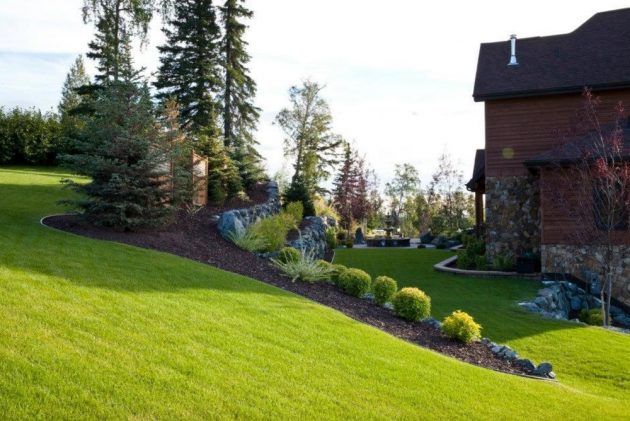
Features
Contractor at Work
Into the wild: Drainage in Alaska
A look into the working conditions, unique challenges and regulations for drainage in Alaska.
August 16, 2019 By Stephanie Gordon
 Because of the environmental conditions in Anchorage, Alaska, Gaskov’s company also dedicates a fair bit of time to installing drainage systems like french drains and curtain drains.
Photo courtesy of Adobe Stock.
Because of the environmental conditions in Anchorage, Alaska, Gaskov’s company also dedicates a fair bit of time to installing drainage systems like french drains and curtain drains.
Photo courtesy of Adobe Stock. Alaska is not likely the first state that comes to mind when thinking about land drainage. While commonplace in the Midwest, agricultural drainage is not a hot topic among Alaska’s drainage industry, but water management is key for the state’s contractors, and for good reason.
Alaska has the greatest surface water resources of any state in the United States, and accounts for 40 percent of the country’s surface water outflow, according to Alaska’s Department of Natural Resources. The state receives a lot of rain – approximately 1,050,000 million gallons per day – and its capital city of Juneau rains for almost eight months of the year. In addition, flooding and erosion cause millions of dollars of property damage each year. With excessive rainfall, consistent snowmelt and ice jams causing flooding, Alaska is no stranger to the need for water management systems.
“Drainage is probably one of the most important parts of doing landscapes,” Konstantin (Gus) Gaskov says. Gaskov is the owner of Green Acres Landscaping in Anchorage, AK, where his company has been designing, installing and maintaining landscapes for 25 years. Because of the environmental conditions in Anchorage, Gaskov’s company also dedicates a fair bit of time to installing drainage systems.
Born in Russia, in northeast Siberia, Gaskov and his brother started a commercial landscape company where they picked up skills doing general landscaping, working with grades, and drainage work. In 1991, Gaskov made the move to the United States and started Green Acres Landscaping in 1993. Nearly parallel on the map to his home country, Alaska was a natural fit. “It was a really easy transition. I didn’t have to reinvent the wheel; I went from frozen ground to frozen ground.”

Nearly parallel on the map to his home country, Alaska was a natural fit. Photo courtesy of Adobe Stock.
A typical season
Anchorage is a coastal city, located in the southern region of the Alaska, tucked between a large inlet and mountains. While not as wet as Juneau, the city’s amount of rainfall is more comparable to Seattle, and spring snowmelt adds to runoff over the landscape. To aggravate the situation even more, Anchorage has a high water table and most of its soils are clay and peat. These types of soil hold water, and with the consistent rain, are always saturated. “Anchorage is six months on, six months off with frost. When [the ground] freezes it expands highly so anything you have on top of that soil or within that soil will be squeezed or pushed,” Gaskov explains.
“Anchorage is six months on, six months off with frost. When [the ground] freezes it expands highly so anything you have on top of that soil or within that soil will be squeezed or pushed.”
Like most drainage projects, work is entirely weather dependent, and most of the work gets done during those frost-free months. Projects in Anchorage start when the ground is completely defrosted. The earliest Gaskov remembers starting was the second week of April, but the season typically begins in the first week of May. The summer team for Green Acres increases to five crews, each made up of four people, in addition to an entire trucking division and a core team of three people. The season usually wraps up in the first week of October, but can continue until the first week of November, depending on the temperature. “Once the ground freezes, six inches to one foot below grade, it becomes extremely difficult and expensive to do any kind of excavation so we stop work at that point,” Gaskov says.
Needless to say, weather is an extreme challenge. “Imagine digging in a drainage trench in the clay and peat when it’s pouring rain. And the rain does not let up for a week . . . You can start the project when it’s nice and sunny and 76 F, but by tomorrow, it starts raining and doesn’t stop for 10 days. All the material you’re digging out, especially clay, it’s very runny. And you’re working on the slope of a hill. So all the material gets saturated with water and it’s just mud oozing back into the trench.”
Gaskov explains this is also frustrating for the customer who deals with the project being delayed time and time again because of weather. To work around this, Green Acres Landscaping tries to complete as many drainage projects during June, which is the dry time. In August when it’s starts raining heavy, Gaskov advises customers to wait until next June to avoid issues of contamination into the drainage. “We like to pre-plan several months in advance, pre-book our projects, and go into the job during the dry months,” Gaskov says.
A typical day in June is sunny with temperatures in the upper 70s and 80s, quickly drying the ground. But sometimes, customers can’t wait for drier weather, and while not ideal, working with frozen ground is the only option. “You have to go in, sometimes with the jackhammer, to break through a foot or two feet of frozen ground, just to dig into the trench,” Gaskov says. “Most of the times, even at 10 below, as long as you break through the crust of frost, if it’s not too far into the winter, you can dig to softer soil and can still dig a trench and seal it up with drainable material.”

Gus Gaskov is the owner of Green Acres Landscaping in Anchorage, Alaska, where his company has been designing, installing and maintaining landscapes for 25 years. Photo courtesy of Gus Gaskov.
Certification
In Alaska, a contractor needs to be licensed to do drainage work. Contractors apply to be certified as either a general, specialty or mechanical contractor from the state’s Department of Commerce. However, under specialty contractor trades, there is no option to select drainage, making it difficult to narrow down how many drainage contractors are in the state. A contractor can select excavation or landscaping, the latter which includes “water drainage systems, dewatering, and ponds” in its expanded definition.
“Any guy with a small excavator and a Bobcat can call themselves a drainage contractor and anybody can advertise. Because [drainage] is a big issue in Anchorage, it’s a craftable niche in the market, and anybody and everything is trying to get into it and do the work,” Gaskov says.
“Any guy with a small excavator and a Bobcat can call themselves a drainage contractor and anybody can advertise. Because [drainage] is a big issue in Anchorage, it’s a craftable niche in the market and anybody and everything is trying to get into it and do the work.”
Gaskov explains that while homeowners can find a less expensive contractor, they end up paying more in the future. “The main thing is make sure that the contractor has enough experience and references, references, references. Making sure that they call and ask past clients of that contractor that he does exactly what’s promised.” Gaskov explains it’s easy to skip certain steps, to use the wrong type of materials, to not dig deep or wide enough, or to skip the municipal inspection procedure in an effort to cut costs. “Homeowners will never know the difference, but a contractor knows.”
About 10 percent of Green Acres’ drainage projects are re-doing existing projects, which makes for some uncomfortable meetings where Gaskov explains to a homeowner that their project needs to be redone. This inconsistency among contractors is not an issue unique to the state; even in places where a licensing program for drainage contractors exists, the problem of installing tile without a license still persists.
Learning the trade
Gaskov went to college for landscape architecture and through the nature of work in Anchorage, he learned more about excavation and drainage. To build on his knowledge, he attended courses in different states, including some in Alaska. He attended several courses hosted by the U.S. Army Corps of Engineers and recommends them to other contractors. “They’ll have general drainage courses, materials too, depth, width, type of piping, where and how to drain, surface water, and so on . . . most contractors don’t even know that.”
When the Green Acres team sees a drainage problem they haven’t encountered, they’ll bring together fellow team members to brainstorm on site. If a solution still isn’t found, they’ll come up with a couple of solutions and consult an engineer. “Most of the times an engineer will pick one of the solutions, maybe tweak it a bit and sign off on it. That gives us a sense of security that we’re on the right track,” Gaskov says.
All crew leaders for Green Acres are required to take classes, in addition to their previous formal training, to stay up to date. Informal education is just as important. Gaskov finds that experience and troubleshooting through a range of situations gives a contractor a solid knowledge base to work from.
A typical project
Anchorage doesn’t have much in terms of agriculture, and though some agricultural communities lie fairly close to the city, they’re located in the valley with fewer drainage issues. Most of Gaskov’s customers are homeowners looking for ways to divert water from damaging their homes.
With little flat land left in Anchorage and a growing population, residential development moved upward to gain more ground. One hillside neighborhood grew to around 1,000 homes over the years. Each new addition was impossible to ignore because of what it meant for the houses below.
“About three to five years after those houses were built, we started getting quite a few calls from that area,” Gaskov says. During construction, developers disturbed rock when trying to make levelled land for houses. Most of these homes, which sell for between $500,000 and $1,000,000, were being built facing the inlet, with the backs of the houses facing the mountain. Newer construction, 100 yards above an existing home, blasted, drilled and disrupted the hillside, creating cracks for water to flow. Gaskov remembers finding all kinds of little fissures in the ground, which explained why basements were flooding and front yards were resembling swamps. To protect the homes, Gaskov and his team mostly installed curtain drains. The curtain drain prevents any moisture going beyond its particular line of defence, and moves the water around the house to a drain in a designated point.

A typical project would see 160 ft. curtain drain wrap around a house to protect it from flooding and the team brings the yard back to shape through landscaping after. Photo courtesy of Gus Gaskov.
A typical project like this would see up to a 160-foot sheet of curtain drain installed, wrapping around the back of a house that averages 60 feet wide. A two-foot wide trench is dug to a depth of six to eight feet behind the house. Industrial fabric lines the trench to prevent soil from leaking into the ditch, combined with corrugated or perforated pipe (either one or two six- or eight-inch pieces of pipe) to capture and re-direct water. The entire trench then gets filled with drainable (usually sewer) rock.
The lots are located up a hill so only small excavators can be used, meaning a typical house project takes between four and 10 days to complete. Gaskov explains a project like this costs in total between $15,000 and $30,000. The cost includes the approximately $5,000 added for the landscape work to bring the yard back into shape after a drain is installed.
Regulation in Anchorage states that surface water is the responsibility of the homeowner that the surface belongs to, but underground water is not. If water from one yard drains onto a neighbor’s lot, it’s the original homeowner’s responsibility. But if a homeowner’s basement floods because a fissure opened up during the construction of a new house above the original, there is no way to prove the flooding is caused by the new neighboring build. “We all know, in the industry, that’s exactly what happened, but because it’s underground it becomes the responsibility of the homeowner below,” Gaskov says. “So in other words, it’s just being out of luck.”
Opportunities for drainage in Anchorage
While the nature of work in Alaska is different from the Midwest, similarities emerge that are consistent with drainage contractors in other states. “Nobody worries about drainage until they actually come across the problem,” Gaskov says.
Across the world, drainage contractors work behind the scenes until they are needed. And where’s there’s water, drainage follows closely behind – whether it’s a farmer with a flooded field, or a homeowner with a flooded basement. Because of this, Gaskov says there are opportunities for drainage contractors in Anchorage. “Anchorage keeps on growing and it’s growing further up the mountain, so I do not see any ending of drainage issues.”
Print this page